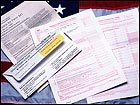
NEW YORK (CNN/Money) -
Never mind that you worked hard for it. There's something about a tax refund that feels like Christmas or a birthday. After all, you've suddenly got money to splurge.
According to the Internal Revenue Service, refund amounts this year are averaging $2,091. That's slightly more than the typical $1,743 refund filers got back last year.
But before you blow those bucks at the track, you'd be wise to consider your options. There are far better ways to put your refund check to use. And while they may lack the instant gratification of a trip to Paris or $300 designer shoes, the long-term payoffs will be well worth the sacrifice.
Here are a few suggestions:
Pay off debts
If you're not paying your debts in full and on time then you're likely spending more on your bills than you would make through most investments. Consider credit cards, for example. Most come with double-digit interest rates, so making minimum payments is a sure-fire way to derail your finances and put you in debt for years or even decades.
Consider, for example, a $3,000 credit card balance with a 15 percent interest rate. If you pay just $50 a month, it will take you 26 years and six months to be debt-free and your total interest will have cost you $6,030.
If you were to you get a fat $1,000 tax refund, you could instead shave that balance to $2,000. If you continue making monthly $50 payments, you'd be debt-free in 10 years and six months and interest payments would total just $1,437. That's a savings of nearly $4,600.
Apply a more modest refund to that debt -- say $500 -- and you'd still pay off your plastic 10 years early, cutting your interest by more than half, to $2,917.
(Use our Debt Planner to determine how much time and money you will save by sending your refund to the credit card company.)
Fund your retirement
You might also consider putting some of your refund into a Roth IRA. This year, you can put up to $3,000 in a Roth (or $3,500 if you're over 50), up from $2,000 last year -- assuming assuming your income does not exceed the annual income thresholds. (The same funding limits apply to traditional and deductible IRAs as well.)
Contributions to a Roth are not deductible, but earnings grow tax-free. That means a one-time $3,000 contribution will be worth $13,983 in 20 years, assuming an 8 percent annual growth rate.
If you don't have the full $3,000, don't worry. Many mutual fund companies, like Vanguard and Fidelity let you open Roths for less -- typically $500 to $1,000. To research funds, as well as opening balance requirements, go to Morningstar.com.
Pay for your kids' education
For parents putting money away for college tuition, a good place to park extra dollars is a 529 college savings plan. These state-sponsored tools have fast become a favorite of financial pros. And with good reason. There are no income requirements to participate. You can put up to $50,000 into these plans tax free in any given year, as long as you don't make additional contributions for another four. And effective this year, you can also take out earnings tax-free if they're spent on qualified college costs.
What's more, chipping into a 529 may help you save money on next year's tax bill. That's because 16 states -- including New York, Colorado and Michigan -- offer state income tax breaks to residents who contribute to their plans.
For more on how to choose the best 529 for you, see our story, "The 529 Solution."
If you're also planning on private school for your child, consider applying your refund toward a Coverdell Education Savings Account (formally known as an Education IRA). Starting this year, earnings from a Coverdell can be spent on K through 12 education, as well as college, and you can now stash up to $2,000 a year in one, up from a paltry $500.
Here too, earnings can be withdrawn tax-free if they're used for bona fide education expenses, such as tuition, books, computers and tutoring.
Setting priorities
If you're like most people, you're probably saving toward two to three financial goals at once. That might include debt repayment, college savings and retirement. Where, then, should any extra dollar -- in the form of your refund check -- be applied.
Traditionally, financial pros urged individuals to knock out high-interest debt first. But that advice comes with a caveat.
"What happens is people forego other goals like retirement while they try to pay debt off," said Denise Gustin-Piazza, a Certified Financial Planner and co-author of J.K. Lasser's Winning Financial Strategies for Women. "But the most important ally you have in saving for retirement is time. So I'd take a little of the refund and fund a Roth IRA, too."
| |
 Related Links
Related Links
| |
| | |
| | |
|
Remember, though, that if you're getting more than a few hundred dollars back from Uncle Sam you essentially gave the government an interest free loan. You'd be wise to adjust your withholdings now so you break even next year.
And what about that splurge you wanted? Assuming there's enough left over after taking care of business, be our guest.
"You've got to reward yourself a little," said Gustin-Piazza. "It's like a diet. If you don't give yourself a treat, you'll blow it. So, yes, take a little bit and do something nice for yourself, too."

|

